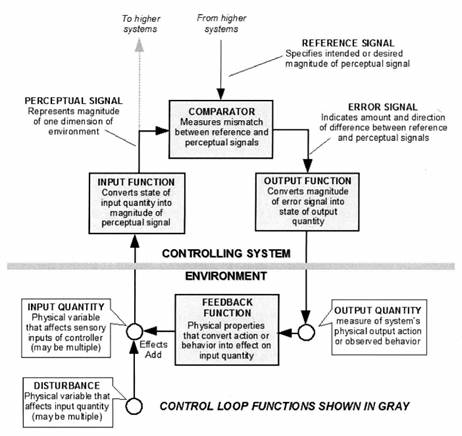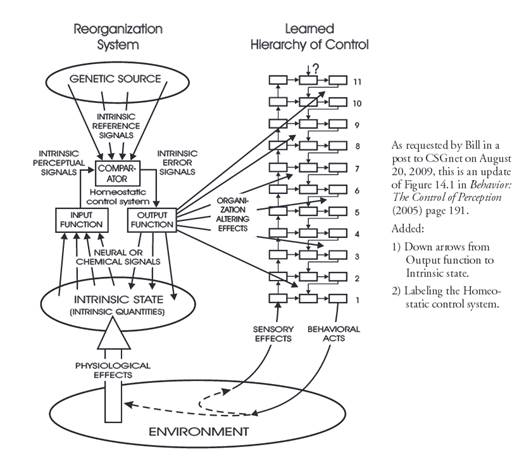Why do you consider it imperative to run an experimental TCV? What’s the difference between measuring the CV and simply asking the person what they are controlling for?
···
On Mon, Oct 19, 2015 at 12:02 PM, Bruce Nevin bnhpct@gmail.com wrote:
Review: Richard S. Marken (2014), Doing research on purpose: A Control Theory approach to experimental psychology. Villa Ridge, MO: New View.
It took a peculiar courage for Galileo to defend and elaborate the Copernican theory that the earth was just one of the planets orbiting around the sun, when the consensus of science was that the sun moves along a celestial sphere that spins about the earth. Such is the courage demonstrated in this third volume of papers by Richard Marken in experimental psychology.
The title points to the problem. Just as the sun is at the center of the solar system, simple introspection tells us that purpose is at the center of behavior. Our actions are not purposeless. But purpose and introspection both were banished a century ago in a drive to make psychology more scientific–and more serviceable to moneyed patrons of science.
The mathematical basis for understanding purpose was worked out by engineers in the 1930s and has been put to work in everything from cruise control to cruise missiles, but behaviorism held the inertial weight of methodologies, money, and professional reputations. Stimuli cause an organism to ‘emit’ responses according to conditioning.
This view was attractive to managers of a discontented workforce and commanders of a volunteer army. Control the rewards and punishments that motivate people, the promise goes, and the direction of their behavior is in your grasp. Note the plural. The individual disappeared into a Gaussian distribution.
The promise to predict and control behavior has been inherited by cognitive psychology, which arose with the invention of the programmable digital computer. ENIAC was announced in 1946 as the first ‘electronic brain’. The metaphor of the digital computer has been irresistable. Cognitive psychology differs from behaviorism by interposing an information processing device between stimulus and response. Marken lays out the inadequacies of this view with devastating effect in paper 9, “You say you had a revolution: Methodological foundations of closed-loop psychology” (pp. 151-175).
Hindsight again and again demonstrates that the secrets of nature are hidden in plain view. The causes of behavior are not out among the stimuli of the environment, they are the purposes harbored within each individual. What counts as a ‘stimulus’ depends upon what matters to the individual. How do you identify and study these interior purposes in a scientific way?
The key insight is that we do not control our behavior. Rather, behavior is variable in just the manner and extent necessary to make our experience be the way we want it to be. The title of the locus classicus of this science of psychology is Behavior: The control of perceptio**n, published in 1973 by William T. Powers.
“The feeling among … psychologists seems to be that simply being aware of the purposeful nature of behavior is a sufficient basis for saying that one is taking purpose into account in one’s research” (p. 1). But mere hand-waving does not a science make. In these papers, Marken demonstrates the methodology of Perceptual Control Theory (PCT) and its ample explanatory fruits.
In “Looking at behavior through Control Theory glasses”, the first essay in this collection, Marken reinterprets a number phenomena that have previously been given stimulus-response ‘explanations’, and he does so with reference to online computer simulations so that the reader can directly experience how the given behavior results from negative-feedback control.
What is a purpose, and how do you identify and specify one? The fundamental step in PCT research methodology identifies a variable in the environment whose perceived state matters to the given subject. This step is called the Test for the Controlled Variable. The preferred state of a controlled variable, its ‘reference condition’, specifies the purpose of the subject with respect to that variable as perceived in the environment. The reference (or setpoint) is inferred to be the condition to which the subject restores the controlled variable when an environmental disturbance affects that condition.
Crucially, this cannot be done without taking the point of view of the subject. What perception is the greylag goose controlling by her ‘egg-rolling’ behavior? What perceptions are the individual birds controlling, such that we outside observers perceive ‘flocking behavior’? What perceptions does a baseball player control in order to catch a fly ball? These and more are explicated in the papers in the first section, “Looking for the purpose of behavior”.
The papers in the second section, “Illusions and confusions”, explain how and why well-meaning scientists have continued to misinterpret behavior for so long. When experimenters expect independent variables to cause dependent variables in a linear way, they control that perception as well as they can by averaging results for many instances of behavior and many behaving individuals. Any statistical results better than a coin-toss are deemed significant and worthy of publication. The actual data of individual behavior are discarded after the statistical analysis. When properly perceived, these data for individuals demonstrate the stabilization of selected variables by variable behavioral means resisting environmental disturbances. The major disturbance in a conditioning experiment is kept virtually out of sight as the ‘establishing condition’ for the experiment, e.g. starving an animal to 85% of its body weight so that it will do whatever it takes to get some food.
Essay 8, “Control theory for whom?”, is a review of a textbook, Control theory for humans, in which two control systems engineers aim to explain control theory to behavioral scientists. Although the technical presentation is excellent, the authors fail to address the perceptions that an experimental psychologist (or sociologist, linguist, etc.) must recognize and control. This is because control systems engineers do not understand control systems from the inside out. What I mean by this is that they naturally assume the point of view of an engineer operating a system and analyzing its performance. The engineer knows in advance what variables are to be controlled, and the engineer reaches into the system and adjusts the reference levels for those variables. An experimental psychologist can do neither. The controlled variables and their reference levels must be experimentally inferred from the Test for Controlled Variables.
This methodological revolution is the subject of the last major section. Paper 9 was mentioned above. Paper 10, “Methods, models and revolutions”, alludes to a shift in the behavioral sciences from statistical methods to the testing of models. However, the models being constructed and tested are still derived from the same old IV-DV methodology. The building and testing of models is fundamental to PCT. This paper succinctly delineates the methodological revolution that is necessary for the construction of adequate models of behavior. Until a working, generative computer model can replicate the measured behavior of an individual with greater than 95% fidelity (preferably greater than 99%), with the deviations from perfect control that are seen in the individual’s actual performance, it is not ready for publication. This is how to raise the so-called ‘soft’ sciences above standards of acceptance that would be laughable in the ‘hard’ sciences a level on a par with physics and chemistry.
As the older generation, deeply committed to the illusions of IV-DV methodologies, retire and die, science will progress so as to replace received opinion, just as heliocentric astronomy eventually replaced the mathematically sophisticated epicycles of Ptolemy. The final chapter of this excellent third collection of Marken’s publications is an imagined 50-year retrospective from the year 2053. Reading this book could be part of your participation that progression from illusion to explanation.

